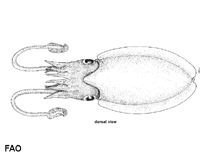Rhombosepion elegans (Blainville, 1827)
Elegant cuttlefish
Classification / Names Κοινά ονόματα | Συνώνυμα | CoL | ITIS | WoRMS
Cephalopoda | Sepiida | Sepiidae
Environment: milieu / climate zone / εύρος βάθους / distribution range Οικολογία
; Υφάλμυρο; εύρος βάθους 16 - 500 m (Αναφ. 1695), usually 150 - 150 m (Αναφ. 1695). Tropical; 60°N - 15°S, 21°W - 37°E (Αναφ. 1695)
Distribution Χώρες | Περιοχές FAO | Οικοσυστήματα | Παρουσίες | Εισαγωγές
Eastern Atlantic and the Mediterranean: from UK to Angola.
Length at first maturity / Μέγεθος / Weight / Age
Γεννητική Ωρίμανση: Lm ? range ? - ? cm Max length : 7.2 cm ML αρσενικό/απροσδιόριστο; (Αναφ. 1695); 8.9 cm ML (female); μεγ. δημοσιευμένο βάρος: 60.00 g (Αναφ. 1695)
Life cycle and mating behavior Γεννητική Ωρίμανση | Αναπαραγωγή | Γεννοβολία | Eggs | Γονιμότητα | Larvae
Main reference
Αναφορές | Συντονιστής | Συνεργάτες
Jereb, P. and C.F.E. Roper (eds.) 2005 Cephalopods of the world. An Annotated and Illustrated catalogue of Cephalopod species known to date. Vol. 1. Chambered nautiluses and sepioids (Nautilidae, Sepiidae, Sepiolidae, Sepiadariidae, Idiosepiidae and Spirulidae). FAO Spec. Cat. Fish. Purp. 4(1):262p. Rome: FAO. (Αναφ. 1695)
IUCN Red List Status
(Αναφ. 130435: Version 2025-1)
CITES status (Αναφ. 108899)
CMS (Αναφ. 116361)
Threat to humans
Human uses
αλιεία: Εμπορικό(ά)
| FishSource |
Εργαλεία
Περισσότερες πληροφορίες
Διαδικτυακές πηγές
BHL | BOLD Systems | CISTI | DiscoverLife | FAO(Publication : search) | Fishipedia | GenBank (genome, nucleotide) | GloBI | Gomexsi | Google Books | Google Scholar | Google | PubMed | Δέντρο Ζωής | Wikipedia (Go, αναζήτηση) | Zoological Record



